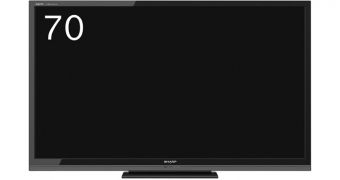In Japan, Sharp has made the official introduction of a beastly liquid crystal display, one that almost puts LG's new 3D, glasses-free monitor to shame as far as pricing goes.
Sharp's new liquid crystal display TV set is a large and high-quality product that, even without featuring support for 3D, has a price to run away from.
For those that believe themselves not to be faint of heart, the exact tag is 550,000 yen.
Based on exchange rates, that sum translates into $7,056 and 5,365 Euro, give or take. March 10 is when sales begin.
There are two main reasons behind this monstrous drain on one's finances: size and color quality.
The screen size of 70 inches makes this one of the biggest of its kind, enabling both TV broadcasts and web browsing at the same time.
Granted, the AQUOS LC-70Q7, as it is called, can't hold a candle to LG's 84-Inch 3D Ultra-Definition TV but, then again, not many products have what it takes for that feat.
The second asset of Sharp's product, that of color quality, is owed to the four color technology, which adds yellow to the common color spectrum (red, green and blue / RGB).
Not only that, but Sharp also provides its UV2A technology, which precisely controls the liquid crystal molecules in the LCD panel.
The resolution of the 70-inch Sharp AQUOS LC-70Q7 is 1,920 x 1,080 pixels (Full HD) and the company recommends a viewing distance of at least 2.6 meters (8.53 feet).
The rest of the specifications mostly deal with connectivity, and this extends to more than the regular TV cable inputs and the like. The HDMI input is a must have at this point, as is the composite video port and analog RGB.
Optional wireless LAN can be selected as well, without which the aforementioned ability to browse the web is unavailable.
Finally, an USB port is present as well, so that owners may link an external hard drive unit to the AQUOS LC-70Q7 and, by means of two digital tuners, record real-time TV.
As for energy savings, Sharp threw in automatic screen brightness adjustment based on ambient light.

 14 DAY TRIAL //
14 DAY TRIAL //